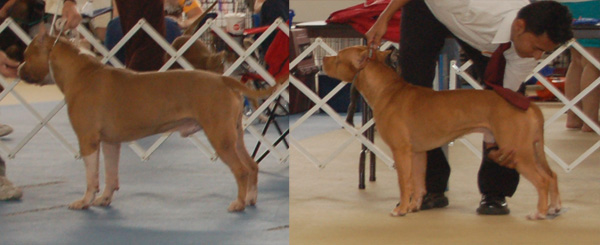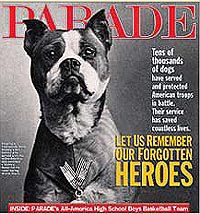Rear Study 1
The hindquarters are strong, muscular, and moderately broad. The rump is well filled in on each side of the tail and deep from the pelvis to the crotch. |
The bone, angulations, and musculature of the hindquarters are in balance with the forequarters (Figure 14 and 15) . |
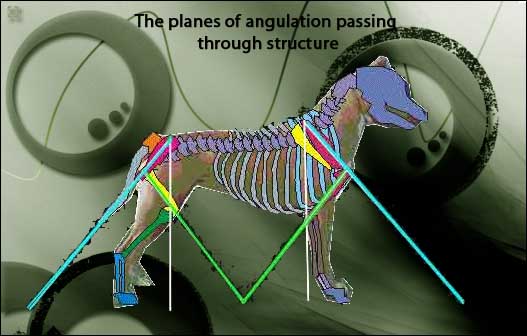 |
| FIGURE 14 - This is an APBT with a virtual X-ray. The white lines indicate the proper way to measure for that all ellusive "ANGULATION" . |
| Figure 14 takes away the dog and skeletal structure so that the angles can be better seen. Notice that similar to measuring height and length the same skeletal processes are used for estimating (different from measuring) angulation. |
| FOREQUARTERS- The withers forward to the point of the shoulder where the humerus meets the scapula and on to the ground BLUE LINE (refer to FIGURE 2 and 3) provide the first plane. The second plane extends from the point of the shoulder through the elbow to the ground GREEN LINE (note that a WHITE LINE perpendicular to the ground in a proper conformation extends from the point of the shoulder through the elbow). THe angle between the blue and green lines should be close to 90 degrees. The angle of the blue and green lines with the ground should be between 30 and 35 degrees depending on the musculature and stance of the dog in stacked position. Proper balance of muscle and proper angulations result in about a 32 degree angle to the ground. This same method also is performed for the HINDQUARTERS. The blue line extends from the upper point of the hip bone (pelvis), through the farthest fore point of the femur and on to the ground. Again the angle between blue and green should be 90 degrees and a line from the top of the pelvis perpendicular to the ground should pass through the "True knee" or where the femur ( YELLOW BONE) meets the tibia ( GREEN BONE ) |
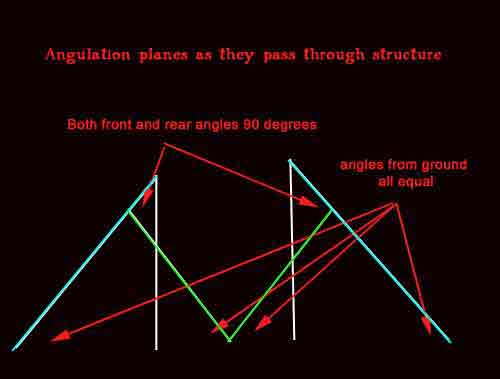 |
FIGURE 15 - These are the same lines as in figure 14 minus the musculo-skeletal depiction. This merely points out the angles both in the shoulder and hips and the angles with the ground. Notice how the two GREEN lines extending inward meet at the exact point on the ground. |
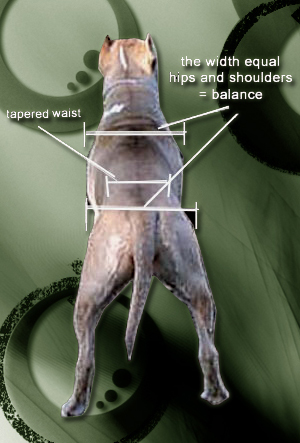 |
FIGURE 16 - This shows another meaning for balance which is the musculo-skeletal balance between the hips and shoulders. The shoulders width and the width of the hips should be close to equal. Again and AGAIN the APBT is a study in averages and balance. Over done front or rear do not fit with the need for versatility. The thighs are well developed with thick, easily discerned muscles. Viewed from the side, the hock joint is well bent and the rear pasterns are well let down and perpendicular to the ground. |
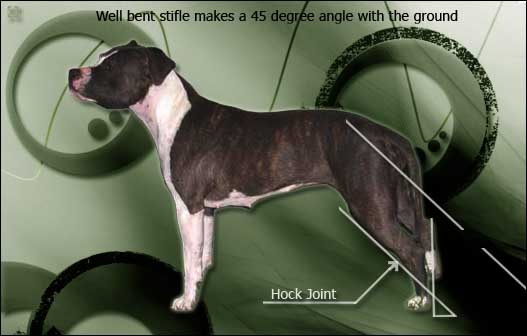 |
| FIGURE 17 - This figure shows the location of the hock joint and shows the rear pasterns perpendicular to the ground. A proper angle for the hock joint would be roughly 45 degrees with the ground . Notice the stifle angle matches the croup or coxae anglepasterns are standing parallel to the ground while the topline is maintained. Dogs without proper angulation can be made to appear to have a good amount of angle to the hock joint but in so doing it drops or raises the topline out of plane and straightens the stifle. When stacking the hockjoint angle should be no more or less than that required to put the rear pasterns perpendicular to the ground while maintaining a flat topline (if possible). The APBT should not have too little or too much angulation ( AVERAGE AND MODERATION ). However, lack of angulation and lack of stifle (straight stifle) is a curse of a working breed and should not be encouraged at all. |
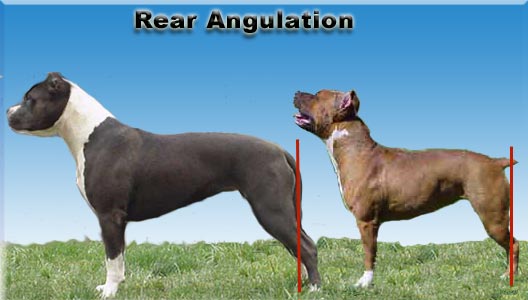 |
|
This graphic shows a dog on the left with many faults. This dog has a straight front end with no layback, straight stifle, too slanted of a coxae, flat pasterns and high tail set. The dog to the right epitomizes the UKC standard. Well-layed back shoulders, tuck, flat backline, arched at the croup to a low tailset, well turned stifle, moderate pasterns. ANOTHER EASIER METHOD FOR VISUALIZING REAR ANGULATION- "With the dog standing with hocks perpendicular to the ground, drop a line from the REAR MOST POINT of the buttocks perpendicular to the ground. In a dog with correct angulations this line should fall directly in front of the toes of the hind foot. If the dog lacks angulations, left picture above, it will run down through the foot, if over angulated, right picture above, the line will fall well in front of the toes ." |
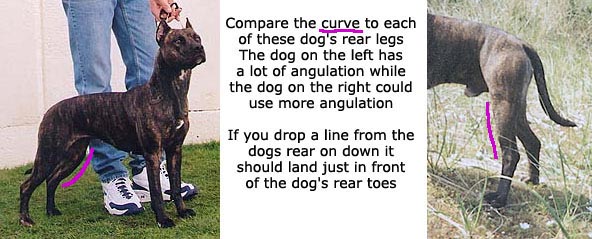 |
| Figure 17B -another way to visualize necessary structure of the rear is looking at the curve to the stifle. A straight stifle is one of the worst conformation flaws. Moderate to well turned is vital. Here we see a graphic where the purple curves illustrate a dog with good stifle and a dog with straight stifle. Thanks to Shana Bobbitt for providing the graphic. |
 |
The above graphic displays the correct angles for an APBT and a comparison to a structure lacking correction angulation. Notice the length of the Tibia. In the image depicting "lacking angulation" we see one of the PRIMARY problems exhibited by the modern "show pit bull". The coxae is too flat and the angle of the coxae and femure is less than 90 degrees and the length of the tibia is stunted. These issues SEVERELY limit the functionality of the rear drive train of a dog that is noted for "working from its rear". Remember it is a well known fact that a fighting dog WINS by wrestling ability and a fighting dogs rear drive is what keeps the dog from being driven back. The head cannot win a fight if it cannot gain position. Lacking a proper rear mechanism is lacking ALL functional ability. |
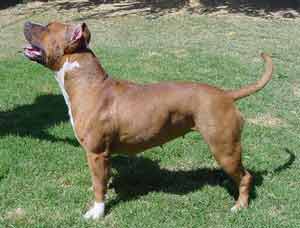 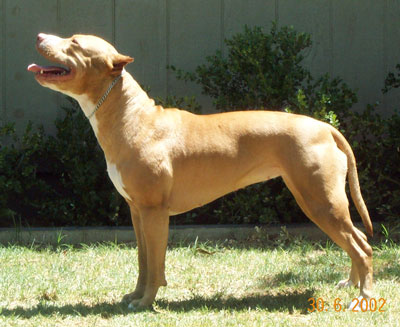 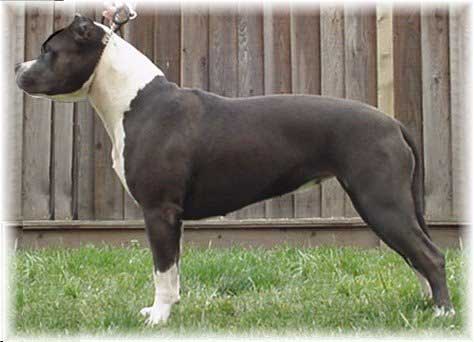 |
FIGURE 18- STACKING- These figures show three very well put together females in proper stacked positions. The first two females are free stacking looking up with a big smile at their humans. The dog to the right is being stacked with her head at the proper angle with lower jaw level with the ground and she definitely has her "game face" on. The dog to the left has poor angulation, the middle dog moderate, and the dog to the right has great angulation. |
 |
| The image above depicts 3 APBT with differnt degrees of angulation and turn to the stifle. The dog to the left has well balanced moderate angulation. The shoulders a a bit upright rather than well layed back but the rear angles match. This female definitely has well turned stifle. the middle dog has well-layed back shoulders with balanced angulation front and rear and well-turned stifle. The final male the the right has upright shoulders unbalanced angulation, and no turn to the stifle (straight stifle). THE APBT MUST HAVE A WELL TURNED STIFLE. This is where all of the work of an athlete and wrestler originates. this is where true power is derived. Straight stifle is like trying to push off of sticks rather than legs. the leverage discussion link will provide more information on this and a future rear study page will provide diagrams of how muscle insertions and these "mysterious" angulations work together to create power and drive. |
Viewed from the rear, the rear pasterns are straight and parallel to one another. |
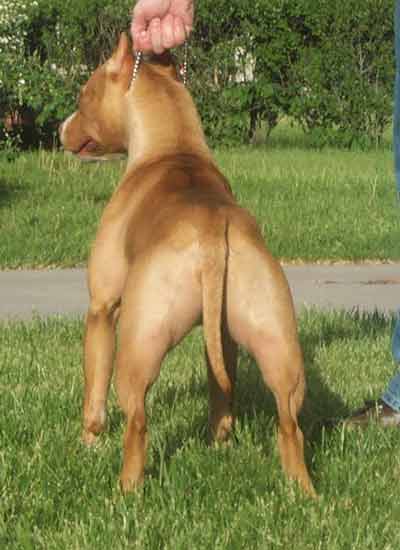 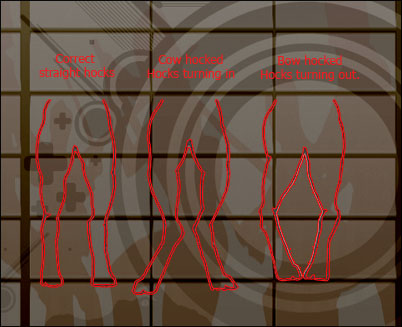 |
Though not stacked perfectly the rear hocks are obviously straight and parallel in the female to the left. The graphic on the right illustrates parallel (correct), hocks turning in (cow hocked), and hocks turning out (bow hocked). |
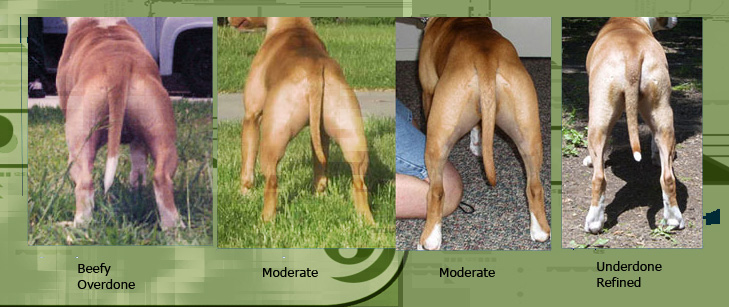 |
| The above graphic shows the range of acceptable rear substance and musculature. The dog to the left is overdone and too massive. The middle two are moderate and the dog to the left is too refined and needs muscle. In ADBA The two to the left would be considered too beefy. |
To visualize rear stucture both good and bad after you read this page visit our rear study pages |

